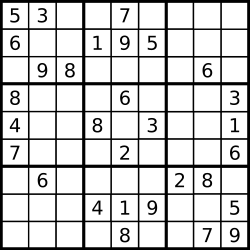Determine if a Sudoku is valid, according to: Sudoku Puzzles - The Rules.
The Sudoku board could be partially filled, where empty cells are filled with the character '.' .

A partially filled sudoku which is valid.
Note:
A valid Sudoku board (partially filled) is not necessarily solvable. Only the filled cells need to be validated.
<Solution>A valid Sudoku board (partially filled) is not necessarily solvable. Only the filled cells need to be validated.
這題不是要解速讀,而是去檢查目前速讀上的數字是否符合規則
- 每個 row,要有 1 - 9,不能有重複
- 每個 col,要有 1 - 9,不能有重複
- 每個 3x3 的小方塊,要有 1 - 9,不能有重複
因為題目只是要問目前填上去的數字,是否符合規則,沒問可不可以解
所以只要檢查是否有重複就可以了
基本想法就是用個二階矩陣,去看是否某個數字已經用過了
例如 : row[9][9],代表每個 row 可以放 1 - 9 的數字,有用過就設為 true
現在在 row = 0 檢查到 8 這個數字,如果 row[0][7] = true,代表重複,反之就是可以用
比較要注意的是小方塊的檢查,該怎麼做 indexing
首先,有九個小方塊,每個小方塊裡面有九個小格
所以其實也是可以看成一個 9x9 的矩陣
row 的 index 算法是,3 * (row / 3) + (col / 3) => 因為小方塊是 3x3,row 和 col 每三個一組
col 的 index 就是 0 - 8
然後在討論區看到一個神解,其實不用用到二階矩陣
想法如下
- row、col、小方塊都用一個長度為 9 的 int array 來檢查是否重複,初始值是 0
- 每個 int 的前9個 bit 就拿來當做 true / false 用 => 所以不用二階矩陣
- 所以是用 bit operation 來檢查是否用過 => 速度也快
code 如下
c++kotlin

沒有留言:
張貼留言